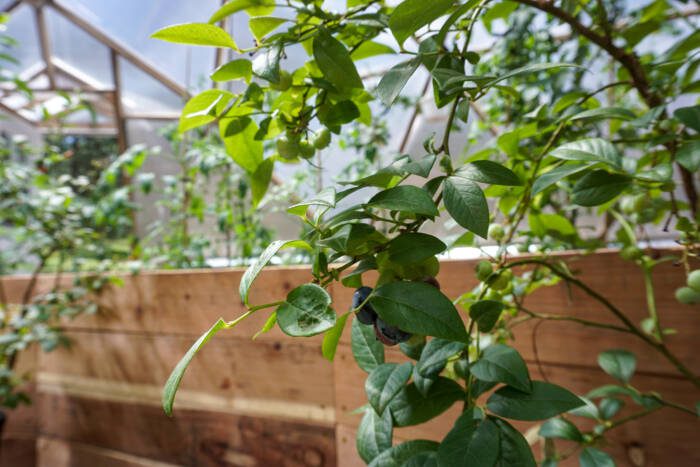
When it comes to cultivating a fruitful and diverse garden or greenhouse, growing blueberries and strawberries can be an exciting endeavor. These fruits have different preferences but can thrive together. However, birds pose a threat as they love snacking on these delicious treats. Growing them in a greenhouse offers protection, ensuring a bountiful harvest without bird damage. Now, let’s explore tips and techniques for cultivating these delightful fruits side by side.
Why Grow Blueberries and Strawberries?
Blueberries, scientifically known as Vaccinium, were once exclusively found in the wild in North America. Thanks to the pioneering efforts of Elizabeth White and Frederick Coville, blueberries emerged as a thriving commercial crop in the early 20th century. Packed with high levels of antioxidants and Vitamin C, blueberries are hailed as a superfood. They also offer essential nutrients such as Vitamin B6, phosphorus, and manganese, which are crucial for bone health, clotting, and brain function.
Strawberries, scientifically known as Fragaria x ananassa, are members of the Rosaceae (Rose) family. Originating from France, these delicious berries are a hybrid of two different species. Fragaria virginiana, native to North America, and Fragaria chiloensis, native to Chile, played vital roles in the development of the garden strawberry we know and love today. Bursting with Vitamin C, fiber, folate, and antioxidants, strawberries offer a range of health benefits. They are known to reduce oxidative stress, lower the risk of heart disease, and even contribute to the prevention of Alzheimer’s disease.
Cultivation Tips for Growing Blueberries and Strawberries


Blueberries: Growing blueberry bushes is relatively easy, but they require a maturation period before fruit production begins. During the first two years, it’s important to remove blossoms to establish the bush. By year three, you can expect a bountiful harvest. Blueberries thrive in full sun and benefit from pine or sawdust mulch, regular watering (1-2″ per week), and well-drained, moisture-retaining soil. Achieve an optimal soil pH of around 4.5 and consider planting multiple varieties together for improved yield. Keep your berries safe from birds by growing them in your greenhouse.

Strawberries: Strawberry plants are also beginner-friendly, but they have their preferences. These plants require 6-10 hours of direct sunlight daily and thrive in a well-drained, loamy soil. Aim for a soil pH between 5.5 and 7, and avoid planting them where tomatoes, eggplants, or peppers were recently grown. Provide ample space for runners, spacing the plants 18″ apart. Avoid bending the roots during planting, and water the plants immediately to aid their settlement.
Strawberry cultivars classify strawberries into three types: June-bearing, everbearing, or day-neutral. In the shorter days of spring, June-bearing strawberry plants bloom and set fruit, yielding their entire crop within a two to three-week period. On the other hand, ever-bearing strawberry plants produce two crops annually: a larger crop in spring and a smaller crop in the fall. Day-neutral plants follow a different pattern, as they rely on temperatures ranging between 35 and 85 degrees Fahrenheit to flower and set fruit. Notably, day-neutral plants have the advantage of producing fruit in their first year of planting.
Berry Fun Facts – Get it? Berry Fun?!
- Another name for blueberries is “star fruit”. North American indigenous peoples called them star fruits because of the five-pointed star shape at the blossom end of the berry.
- One blueberry bush can produce up to 6,000 blueberries per year.
- Did you know that blueberries fight belly fat? In clinical trials blueberries destroyed belly fat.
- British Columbia grows the most blueberries in the world. B.C. = Blueberry Champion! 🏆
- Did you know that strawberries are a member of the rose family? 🌹
- Strawberries have an average of 200 seeds each and botanists consider each seed a fruit.
- Strawberries are the first fruit to ripen in spring and are eaten in 94% of US households.
- The word strawberry comes from the Old English streawberige. The word straw in Old English has two meanings: straw, but also to strew which may refer to how the plant sends out runners and the berries appear to be “strewn” or it could refer to how the runners resemble straw.
Blueberry and Strawberry Companion Plants
Now, let’s delve into the world of companion plants for blueberries and strawberries. Despite their joint appearance in the grocery aisle, remember that these fruits have specific preferences and requirements for flourishing.
Companion Plants for Blueberries: When it comes to optimizing blueberry growth in your greenhouse, selecting the right companions is essential. Columbine, ferns, thyme, hydrangea, and strawberry are excellent choices. Additionally, consider evergreens, dogwood trees, and rhododendrons to create a thriving ecosystem for your blueberries.
Companion Plants for Strawberries: To enhance the growth of strawberries in your greenhouse, carefully choose their companions. Alliums, borage, spinach, lettuce, dill, sage, and marigolds work wonders alongside strawberries. These plants provide benefits such as pest deterrence, improved pollination, and weed control, resulting in healthier strawberry plants.
How to Harvest Blueberries and Strawberries
Blueberries are ready for harvest between June and August. Allow the plants to mature for a couple of years before they yield abundant fruit. During the first years, remove any blooming flowers to aid in plant establishment. Once the plants reach around 6 years of age, expect a full berry production. Harvest fully ripe blueberries, which typically takes 6-7 weeks from the initial ripening. Pick the berries when they are at their peak flavor.
Strawberries ripen 4-6 weeks after blossoming. Optimal harvesting is in the morning, every three days. Select fully red berries and leave them for an extra day or two for added sweetness. Cut the berries by the stem to avoid plant damage. June-bearing strawberry plants produce fruit for about three weeks in outdoor gardens. Freeze any surplus strawberries for up to two months.
We hope this has been “berry” helpful for you in your gardening journey! Berry on!
You might also enjoy: How to Growing Fruit Trees in a Greenhouse, How to Grow Fig Trees in Your Greenhouse, How to Keep Your Greenhouse Cool in the Summer
